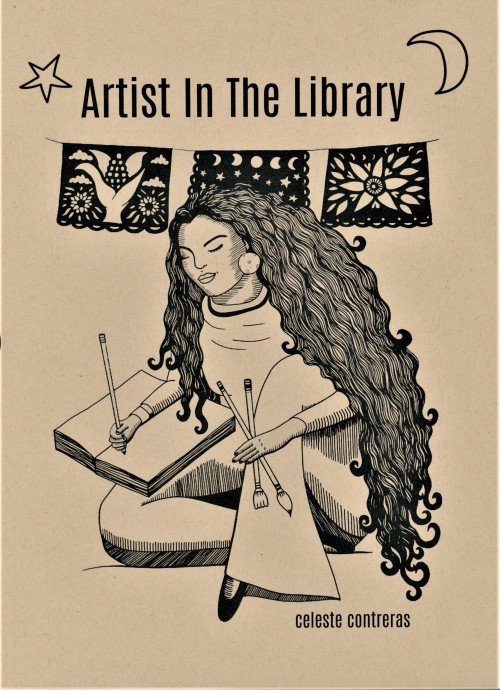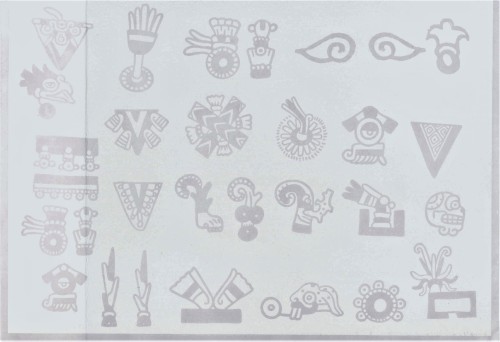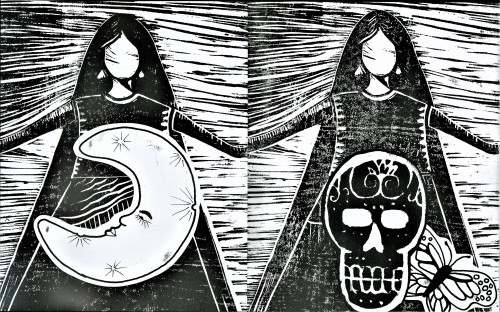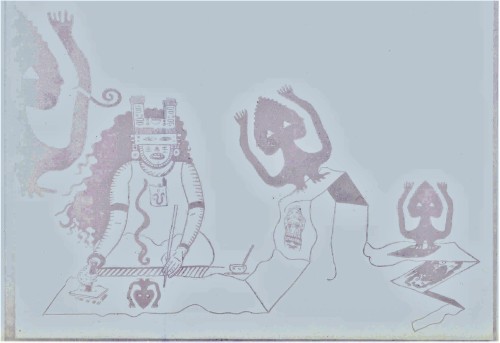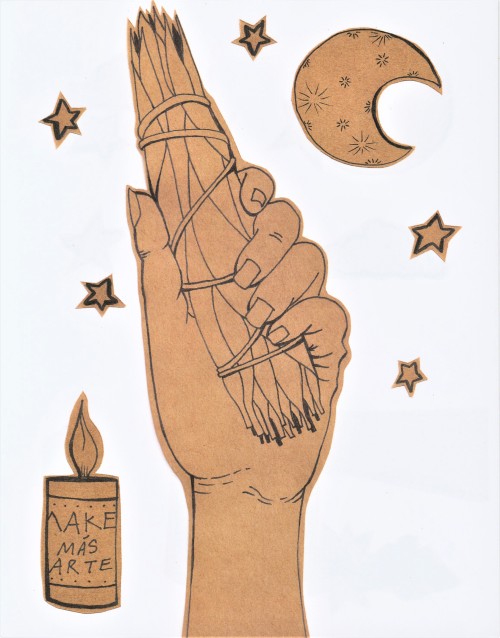#graduate students
Cinco de Mayo
CELESTE CONTRERAS
ForCinco de Mayo, we are proud to present some of the work of a UWM MFA student who has spent a considerable amount of time in our Special Collections in her 3-year graduate career at UW-Milwaukee. Celeste Contrerasis a Xicana-Indigenous artist and activist from Milwaukee who works in a variety of media and narrative forms, such as drawing, painting, printmaking, illustration, installation, animation, public art, and especially artists books. The images shown here come from two of her publications:
- Artist in the Library, published in a limited edition of 200 copies in 2019, is a three-volume set created as a reflection of her time as the 2019 artist-in-residence at the Mitchell Street Branch of the Milwaukee Public Library.
- Cuicatl Xochitl(Song Flower), an artists book produced in an edition of three copies in 2021, presents a series of ghost images; they are so light they are barely there (we had to really enhance the images to make them visible here). The prompt for the visual narrative is based on the cuicatl, the flowering symbol that emerges from the mouth signifying voice. Of this book, Contreras writes:
Sometimes we lose our voices; in transmission – in translation. Sometimes we disappear. But if you look at a certain angle – it’s right there before your eyes. This book is about erasure and impermanence… . Though the actual images are barely there, those who want to see will see and those who do not look they might not see it.
In her practice, Contreras establishes herself as a contemporary Tlacuilo – a scribe, bookmaker, storyteller – a common visual element throughout her current work. This choice is not surprising, especially in her very specific connection to our Special Collections: Contreras chose to do her MFA work at UWM specifically to work with our department head Max Yela, who is also on graduate faculty in the Department of Art & Design with a specialty in the book as an art medium.
Contreras recently completed the installation of her graduate thesis exhibition and it is fantastic! She will be defending her thesis later this month. Congratulations Celeste!!
Make Más Arte!
Post link
Meet intern Maddi Brenner, third-year graduate student in the coordinated master’s degree program for Library and Information Science (MLIS) and Urban Studies (MS). She is in her final year of the program and plans to graduate in May 2022.
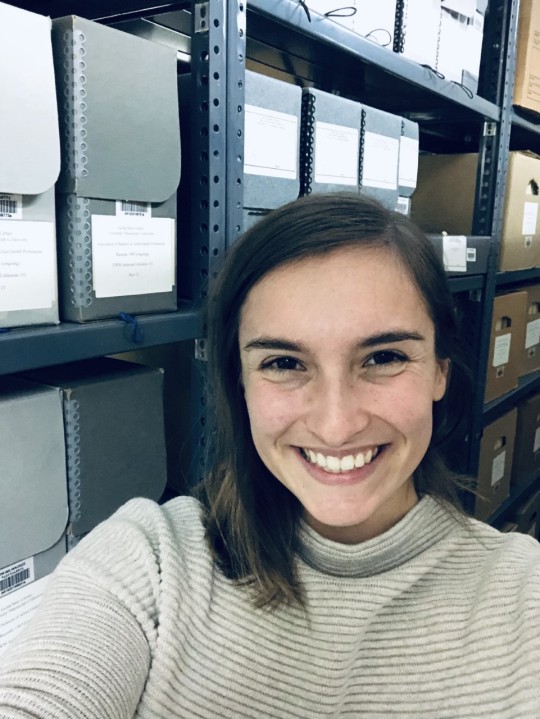
What is your area of study and research interests?
My research interests include urban history, public libraries, mental health & pedagogy, and anything archives.
Tell us about your thesis research and field work.
I am currently in the research phase of my thesis. I am analyzing the expansion of branch libraries and the implementation of a coordinated branch library system in the city of Milwaukee during the 1960s and 70s. I am reviewing the goals of the plan, its development and success post-construction. So far, I have noticed several discrepancies in funding and budget allocations, library location issues, council disagreements and neighborhood dynamics involved in library development.
I am also a fieldworker at Marquette University where I am processing the previously restricted collection of Joseph McCarthy (JRM). If you are interested in any random facts about the 1950s, I seem to have copious amounts of knowledge on the topic. One thing I am working on now is transferring relevant material related to and by Jean Kerr Minetti (the wife, and later widow, to Joe) from the JRM collection to its own open series. The documentation of women involved in the life of famous male figures is not often represented or even in its own narrative. The goal is to connect a sort of interrelatedness to the two series, but ultimately allow the individuals to stand alone in their interpretation.
It reminds me that although work has and is being done to address issues in collection arrangement and description, there is still more to do.
What draws you to the archives, special collections, or libraries profession?
I am really interested in how primary sources connect us to certain understandings of our history, especially through outreach, reference, and research.
What is your favorite collection within the archive – or most interesting record/collection that you’ve come across?
I don’t have a true favorite, but I do think it’s cool that we hold the Society of American Archivists records. It is a massive collection with over 350 boxes and more than 3,500 digital files. Organization of the material has been re-arranged multiple times with new accessions up to 2018. I am not only fascinated by the history of archiving and collection management, but also how these records shaped issues of privilege, representation, and accessibility in the archives today.
What are you working on now for the archives?
Currently, I am working on research regarding reference and WTMJ film footage. The purpose of the project is to explore the frequency of reference requests and the value of preserving WTMJ footage. I will be analyzing both social media and e-mail as platforms crucial in access and outreach processes.
I also regularly coordinate archive transfers to other Wisconsin schools. It is fun to see what type of material is out there from other repositories and how impactful this program can be for researchers. Wisconsin is one of the only states that has this program, so that’s exciting!
What’s something surprising you’ve learned (about yourself as an archivist or about the profession) since you’ve started working at UWM Archives?
Honestly, I’ve learned that no two days are the same at the archives. There is so much going on and almost always a reference inquiry - whether big or small that I can dive into. There is a common misconception that archivists just sit around in an underground storage room all day and though, I surprisingly love being in the storage rooms, that’s far from the truth. We wear many hats.
MeetBrendan Dooley, a graduate student in the department of Library and Information Science.
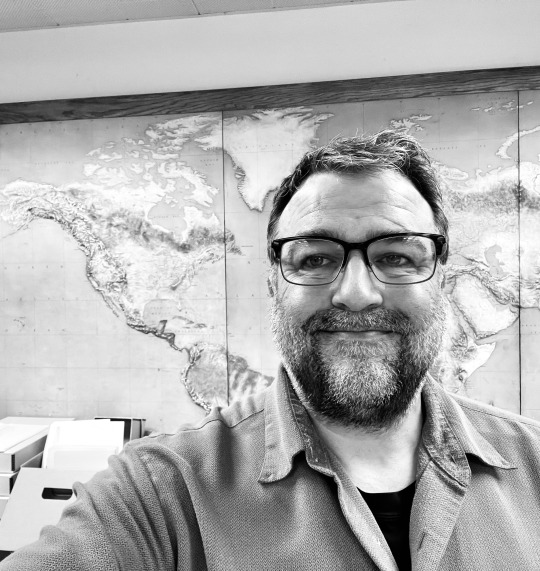
What is your area of study and research interests?
I’ve been intent on the archives concentration since starting my MLIS in Spring 2021, but I could see that changing. This semester I’ve been working as an intern here in the archives as well as a reference intern upstairs in the American Geographical Society Library. I find both places to be incredibly fulfilling places to gain experience and am truly enjoying the reference aspects of each as much as the research sides of what needs to be done. Helping others with their requests is incredibly rewarding.
What year are you on in your program? When do you plan to graduate?
I’m in my third semester of classes right now. I took an archives and library course when I started in spring 2021 semester. I did a three-credit fieldwork class over the summer in the UWM archives where I worked on accessioning the Jim Northrup Papers, which was a fantastic experience (and led in part to my internship in the archives here). If all goes to plan I’ll be able to graduate Winter 2022.
Tell us about your summer fieldwork.
The Northrup accession from my summer fieldwork had me working with the personal and professional writings of Native American author/activist Jim Northrup Jr., an Anishinaabe from the Fond du Lac reservation in Northern Minnesota, not far from the western edge of Lake Superior. He was sent to a federal boarding school at the age of 6, and he was a Vietnam vet, journalist and newspaper editor and columnist, poet, playwright, novelist, writing instructor and more. He began relearning his native Ojibwe language as an adult and started an annual camp to help teach it to others. He and his wife, Pat, made traditional birchbark ricing baskets for chaffing wild rice they harvested from nearby lakes and taught that as well at the camp and internationally at events and readings they were invited to do.
What draws you to the archives, special collections, or libraries profession?
A sincere love for discovering information and growing knowledge, for myself and those around me. I’ve been a writer, journalist and editor for 20 years. Circumstances (due to Covid-19) found me out of a regular full-time gig in summer 2020. I used the opportunity, and the Wisconsin GI Bill, to turn that situation into a positive and return to school for my MLIS, something I had been considering for a year or so — though as a part-time nights/weekends student on a longer path to graduation. My love of journalism, similarly, was wanting to uncover stories and share them with the public — that’s all in the same vein as archival work as far as I can see.
What is your favorite collection within the archive, or most interesting record/collection that you’ve come across?
My favorite collection to come across in the archive, aside from the Northrup collection I’ve been accessioning, is the Charlotte Russell Partridge and Miriam Frink Papers, 1862-1980 ( Milwaukee Mss 167). I was typing different phrases and names into the archives’ Finding Aids search just to get an idea of some of the different collections we have. I typed in my last name and got a hit for my grandfather in this collection. He was an artist in Milwaukee who worked on the Federal WPA project here (which I knew), but there is a photo of a pen-and-ink drawing he did in the collection’s WPA section that I didn’t know existed … and neither did the rest of my family! So it was a pretty cool surprise to find that. I plan to make a copy of it for some reprints to frame and hang among his watercolors we have at home.
What are you working on now for the archives?
My two bigger projects right now are the Northrup Finding Aid so the collection can be live soon and an immense scanning task of SAA papers for an off-site patron.
What’s something surprising you’ve learned (about yourself as an archivist or about the profession) since you’ve started working at UWM Archives?
One of the biggest misconceptions I’ve had about the archival profession is the idea that the archivist is a neutral party. That is the biggest way in which my eyes, and mind, have been opened by the UW-Milwaukee MLIS program and working here in the archives and the AGSL — to take a more critical look at the collections, both what’s here and what isn’t. Why is something here? Who thought it was worth preserving? Why did they think that, and what things were missed or not accessioned? What voices are missing? How can I be a positive influence on the collections and ensure there is access to all who want it?
Meet archives intern Jamee Pritchard, a first-year Ph.D. student in the department of African and African Diaspora Studies.

What is your educational background, area of study, and research interests?
I have master’s degrees in public history and library and information science and a graduate certificate in women’s and gender studies. Very broadly, my area of study is Black women’s history. Within that field, I explore Black feminisms and expressive cultures that focus primarily on print media from the 20th and early 21st century. A lot of my research is about Black women as cultural producers and cultural readers. I seek to understand how writers (re)construct representations of Black womanhood and girlhood within popular print culture. Further, I examine how Black readers engage with this writing in relation to their cultural, collective, and individual identity construction and expression.
Tell us about your thesis and/or field work.
My master’s thesis was a critical history of Black Romance novels from 1980 to 2010. I explored the traditional romance publishing market and the obstacles that Black romance writers faced in a predominantly white literary space that had already established a dominant structure to the romance novel. I analyzed how Black romance writers disrupted that model in their exploration of Black life, and how Black romance readers engaged with these novels. As I’ve just started my Ph.D. program, my doctoral research is a work in progress. I’m developing a project this semester that looks at Black girlhood in young adult popular fiction. I’d love to focus on the impact of YA speculative fiction on representations of Black diasporic girlhoods and really get into the audience reception of these novels through some qualitative research.
What draws you to the archives, special collections, and libraries profession?
The gaps, silences, and erasures of Black women (and other women of color) in the archive, particularly archives within predominantly white institutions, draw me to the profession. What does it mean that our women’s and feminist history collections primarily focus on one historical perspective? What does it mean that many classic Black feminist texts are part of the circulating collection rather than curated within archives or special collections? What does it mean when archival and library staffs lack racial and cultural diversity? In answering these questions, I am interpreting those gaps, silences, and erasures within the archive and, more broadly, the field of libraries, archives, special collections, and museums. My scholarship, through exhibit curation, Tumblr posts, finding aids, academic papers, etc., interprets the value that traditional cultural institutions attribute to the collection and preservation of marginalized histories, and hopefully, it disrupts the existing power structures within these institutions. My professional goals are very selfish, as I simply want to see myself existing in history, and that starts in the archives.
What is your favorite collection within the archive or the most interesting record you’ve come across?
I don’t have a favorite collection in our archive, but I have favorite records. The first is a program from the 1981 Miss Black America of Milwaukee pageant. Vel Phillips was a judge, and the program is found in her collection (Milwaukee Mss 231). The second item is found in UWM Special Collections. It’s a literary journal published in 1979 called Conditions: Five, the black women’s issue. Co-edited by Barbara Smith and Lorraine Bethel, it is the first widely distributed collection of Black feminist writings in the United States. I love the piece called “On Roses and Thorns” by Janet Singleton.
What are you working on now?
I’m processing a small collection for the Black Nurses Association and will move on to processing a collection for the Filipino Nurses Association after that. I’m also working on some outreach through Tumblr posts.
What’s something surprising you’ve learned about the profession (or yourself as an archivist) since you’ve started working at UWM Archives?
Coming into the archives I thought I’d really enjoy the reference aspect of it, which I do, as some reference requests take me on an amazing historical journey, but I’ve learned that I love educational outreach and engagement even more. I really enjoy researching our collections and creating materials and media that make them accessible to students, faculty, staff, and community members.
UWM Archives has some new faces for the academic year, and we’d like to introduce them to you in this weekly series. Every Monday, for the next 3 weeks, we’ll highlight one of our new interns. They’ll describe their education, research, and professional interests as well as share their experience working at UWM Archives.
We start off this series with intern Chloe Joy, a first-year graduate student in the coordinated master’s degree program for Art History and Library and Information Science.

What is your area of study and research interests?
I’m interested in gender studies in an art historical context (particularly during the Renaissance). I’m also interested in collection management, art preservation, and folk arts such as quilting and other textiles! I haven’t quite begun my thesis, but my topic is centered around art depicting pregnancy, sexuality, and maternity during the Italian Renaissance.
What draws you to the archives and special collections profession?
I’m very drawn to the way archives and special collections tell stories and preserve them for generations to come. I get emotionally invested in some of the records I work with, and I find it fascinating to explore people’s journeys through the records we maintain in archives. I have been so lucky to spend time with collections, and I’m dedicated to making archives and special collections accessible for all people, regardless of any status.
What is your favorite collection within UWM Archives or most interesting record/collection that you’ve come across?
I have a degree in Gender Studies, so I really love the collections we have in the archive regarding feminism, women’s history, and the LGBTQ+ community within Milwaukee. I recently processed a new addition to the Wisconsin Women Artists archival collection and had a lot of fun reading through the project documentation (UWM Manuscript Collection 3). The collection contains a lot of interviews with women artists around Wisconsin, on their inspirations, mediums, and artistic processes, which was so cool to read about.
What are you working on now for UWM Archives?
I’m currently working on processing material from UW-Washington County, we’re essentially completing and verifying the description of the collection and removing duplicates that have popped up.
What’s something surprising you’ve learned about the archival profession since you’ve started working at UWM Archives?
One of the biggest things I’ve learned about the profession since working in archives and special collections is truly how important accessibility and diversity are in collections, and how much responsibility those who process and care for archives and other collections have in making sure representation is happening.
So many archival collections have been preserved and controlled by privileged folks in power, and marginalized histories are so often pushed to the side. Archivists now have a duty to foster those marginalized histories and address their own biases within the profession. Working in archives requires a lot of responsibility and intentionality in that regard, since we are uniquely positioned in the role of deciding (to some degree) which stories get preserved, and which do not.
Aspiring Youth Services Librarian; recent library school graduate
by Katrina Wood, one of our volunteer photographers at ALA Annual 2019!
Post link

